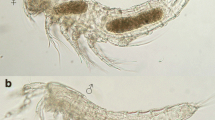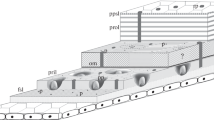Abstract
The cuticular surfaces of Cyphophthalmi (Opiliones) were studied in detail, covering a wide range of their taxonomic diversity. Previously unknown structures are described, including a sexually dimorphic row of spines and glandular openings on leg I of Fangensis cavernarum. Scanning electron micrographs of the prosomal paired hairs and the subapical process are provided for the first time. Evidence for the multi-pored nature of the shaft of solenidia as well as the hollowed nature and absence of wall pores of sensilla chaetica are also shown for the first time using scanning electron microscopy. The prosomal paired hairs may constitute a novel autapomorphy for Cyphophthalmi, as they are absent in all studied members of the other species of Opiliones. Finally, the variation in shape of some of the structures examined may be of great taxonomic value.




Similar content being viewed by others
References
Altner H, Prillinger L (1980) Ultrastructure of invertebrate chemo-, thermo-, and hygroreceptors and its functional significance. Int Rev Cyt 67:69–139
Andersson M (1994) Sexual selection. Princeton University Press, Princeton
Barth FG (2002) A spider’s world: senses and behavior. Springer, Berlin
Berland L (1932) Les Arachnides (Scorpions, Araignées, etc.), biologie systématique, 500p. In: Encyclopédie Entomologique série A XVI. Paul Lechevalier & Fils, Paris, pp 761–793
Boyer SL, Giribet G (2009) Welcome back New Zealand: regional biogeography and Gondwanan affinities of three endemic genera of mite harvestmen (Arachnida, Opiliones, Cyphophthalmi). J Biogeogr 36:1084–1099
Boyer SL, Baker JM, Giribet G (2007a) Deep genetic divergences in Aoraki denticulata (Arachnida, Opiliones, Cyphophthalmi): a widespread ‘mite harvestman’ defies DNA taxonomy. Mol Ecol 16:4999–5016
Boyer SL, Clouse RM, Benavides LR, Sharma P, Schwendinger PJ, Karunarathna I, Giribet G (2007b) Biogeography of the world: a case study from cyphophthalmid Opiliones, a globally distributed group of arachnids. J Biogeogr 34:2070–2085
Bradbury JW, Vehrencamp SL (1998) Principles of animal communication. Sinauer Associates, Sunderland, MA
Chapman RF (1998) The insects: structure and function. Cambridge University Press, Cambridge
Clouse RM, de Bivort BL, Giribet G (2009) A phylogenetic analysis for the South-east Asian mite harvestman family Stylocellidae (Opiliones: Cyphophthalmi)—a combined analysis using morphometric and molecular data. Invertebr Syst 23:515–529. doi:10.1071/IS09044
de Bivort BL, Giribet G (2004) A new genus of cyphophthalmid from the Iberian Peninsula with a phylogenetic analysis of the Sironidae (Arachnida : Opiliones : Cyphophthalmi) and a SEM database of external morphology. Invertebr Syst 18:7–52
Edgecombe GD, Koch M (2008) Phylogeny of scolopendromorph centipedes (Chilopoda): morphological analysis featuring characters from the peristomatic area. Cladistics 24:872–901
Foelix R (1976) Rezeptoren und periphere synaptische verschaltungen bei verschiedenen Arachnida. Ent Germ 3:83–87
Giribet G (2003) Karripurcellia, a new pettalid genus (Arachnida: Opiliones: Cyphophthalmi) from Western Australia, with a cladistic analysis of the family Pettalidae. Invertebr Syst 17:387–406
Giribet G, Boyer SL (2002) A cladistic analysis of the cyphophthalmid genera (Opiliones, Cyphophthalmi). J Arachnol 30:110–128
Giribet G, Prieto CE (2003) A new Afrotropical Ogovea (Opiliones, Cyphophthalmi) from Cameroon, with a discussion on the taxonomic characters in the family Ogoveidae. Zootaxa 329:1–18
Giribet G, Sharma PP, Bastawade DB (2007) A new genus and species of Cyphophthalmi (Arachnida: Opiliones) from the north-eastern states of India. Zool J Linnean Soc 151:663–670
Giribet G, Vogt L, Pérez González A, Sharma P, Kury AB (2010) A multilocus approach to harvestman (Arachnida: Opiliones) phylogeny with emphasis on biogeography and the systematics of Laniatores. Cladistics 26:408–437. doi:10.1111/j.1096-0031.2009.00296.x
Greenfield MD (2002) Signalers and receivers: mechanisms and evolution of Arthropod communication. Oxford University Press, Oxford
Grygier MJ, Ohtsuka S (2008) A new genus of monstrilloid copepods (Crustacea) with anteriorly pointing ovigerous spines and related adaptations for subthoracic brooding. Zool J Linn Soc 152:459–506
Hansen HJ (1921) Studies on Arthropoda I. The Pedipalpi, Ricinulei, and Opiliones (exc. Op. Laniatores) collected by Mr. Leonardo Fea in tropical West Africa and adjacent Islands. Gyldendalske Boghandel, Copenhagen
Hansen HJ, Sørensen W (1904) On two orders of Arachnida: Opiliones, especially the suborder Cyphophthalmi, and Ricinulei, namely the family Cryptostemmatoidae. Cambridge University Press, Cambridge
Juberthie C (1964) Recherches sur la biologie des opilions. Ann Spéléol 19:5–244
Juberthie C (1965) Données sur l’écologie, le développement et la reproduction des opilions. Rev Ecol Biol Sol 2:377–396
Juberthie C (1970) Les genres d’opilions Sironinae (Cyphophthalmes). Bull Mus Nat Hist Nat 41:1371–1390
Juberthie C (1979) Un cyphophthalme nouveau d’une grotte de Nouvelle-Calédonie: Troglosiro aelleni n. gen., n. sp. (Opilion Sironinae). Rev Suisse Zool 86:221–231
Juberthie C (1988) Un nouvel opilion cyphophthalme aveugle d’Australie: Austropurcellia gen. nov., scoparia n.sp. Mem Biospéleol 18:133–140
Juberthie C (2000) A new blind Cyphophthalmi (Opiliones) from Queensland (Australia). Mem Biospéleol 27:149–154
Karaman I (2005) Evidence of spermatophores in Cyphophthalmi (Arachnida, Opiliones). Rev Suisse Zool 112:3–11
Keil TA, Steinbrecht RA (1984) Mechanosensitive and olfactory sensilla of insects. In: King RC, Akai H (eds) Insect ultrastructure, 2ed. Plenum Press, New York and London., pp 477–516
Martens J (1975) Ischyropsalis hellwigi (Opiliones) Paarungsverhalten. Encyclopaedia. Cinematographica E 2128/1875
McAloon FM, Durden LA (2000) Attachment sites and frequency distribution of erythraeid mites, Leptus indianensis (Acari: Prostigmata), ectoparasitic on harvestmen, Leiobunum formosum (Opiliones). Exp App Acarol 24:561–567
Millot J (1949) Classe des Arachnides. In: Grassé PP (ed) Traité de Zoologie, vol 6. Masson et Cie, Paris, pp 263–319
Murienne J, Karaman I, Giribet G (2010) Explosive evolution of an ancient group of Cyphophthalmi (Arachnida: Opiliones) in the Balkan Peninsula. J Biogeogr 37:90–102
Novak T (2005) Notes on spermatophores in Cyphophthalmus duricorius Joseph (Arachnida: Opiliones: Sironidae). Ann Ser Hist Nat 15:277–280
Ochoa R, Pettis JS, Erbe E, Wergin WP (2005) Observations on the honey bee tracheal mite Acarapis woodi (Acari: Tarsonemidae) using low-temperature scanning electron microscopy. Exp App Acarol 35:239–249
Pittard K, Mitchell RW (1972) Comparative morphology of the life stages of Cryptocellus pelaezi (Arachnida, Ricinulei). In: Graduate studies Texas Tech University. Texas Tech Press, Lubbock
Rafalski J (1958) A description of Siro carpaticus sp. n. with remarks on the morphology and systematics of the Cyphophthalmi (Opiliones). Acta Zool Cracov 2:521–556
Savory TH (1962) Daddy longlegs. Sci Amer 207:119–128
Schuh RT, Weirauch C, Henry TJ, Halbert SE (2008) Curaliidae, a new family of Heteroptera (Insecta: Hemiptera) from the Eastern United States. Ann Entomol Soc Am 101:20–29
Schwendinger PJ, Giribet G (2005) The systematics of the south-east Asian genus Fangensis Rambla (Opiliones: Cyphophthalmi: Stylocellidae). Invertebr Syst 19:297–323
Sharma P, Giribet G (2005) A new Troglosiro species (Opiliones, Cyphophthalmi, Troglosironidae) from New Caledonia. Zootaxa 1053:47–60
Sharma PP, Giribet G (2009) The family Troglosironidae (Opiliones: Cyphophthalmi) of New Caledonia. In: Zoologia Neocaledonica 7. Biodiversity Studies in New Caledonia, Paris, pp 83–123
Shear WA (1980) A review of the Cyphophthalmi of the United States and México, with a proposed reclassification of the Suborder (Arachnida, Opiliones). Am Mus Nov 2705:1–34
Talarico G, Palacios-Vargas JG, Silva MF, Alberti G (2006) Ultrastructure of tarsal sensilla and other integument structures of two Pseudocellus species (Ricinulei, Arachnida). J Morph 267:441–463
van der Hammen L (1985) Comparative studies in Chelicerata. III Opilionida. Zool Verhand Leiden 220:1–60
Weygoldt P, Paulus HF (1979) Untersuchungen zur morphologie, taxonomie und phylogenie der Chelicerata. II. Cladogramme und die entfaltung der Chelicerata. Z Zool Syst Evolut-Forsch 17:177–200
Willemart RH, Farine J-P, Peretti AV, Gnaspini P (2006) Behavioral roles of the sexually dimorphic structures in the male harvestman, Phalangium opilio (Opiliones, Phalangiidae). Can J Zool 84:1763–1774
Willemart RH, Farine JP, Gnaspini P (2009a) Sensory biology of Phalangida harvestmen (Arachnida, Opiliones): a review, with new morphological data on 18 species. Acta Zool 90:209–227
Willemart RH, Osses F, Chelini MC, Macías-Ordóñez R, Machado G (2009b) Sexually dimorphic legs in a neotropical harvestman (Arachnida, Opiliones): ornament or weapon? Behav Proc 80:51–59
Willemart RH, Pérez González A, Farine J-P, Gnaspini P (2010) Sexually dimorphic tegumental gland openings in Laniatores (Arachnida, Opiliones), with new data on 23 species. J Morph 271:641–653
Zacharuk RY (1985) Antennae and sensilla. In: Kerkut GA, Gilbert LI (eds) Comprehensive insect physiology, biochemistry and pharmacology, vol 6. Pergamon Press, Oxford, pp 1−69
Zhang J-X, Zhu M-S, Song D-X (2004) A review of the Chinese nursery-web spiders (Araneae, Pisauridae). J Arachnol 32:353–417
Acknowledgments
Ron Clouse greatly helped with SEM micrographs. Richard Schalek of the Harvard Center for Nanoscale Systems assisted with the SEM. Thomas Bartolomaeus and three anonymous reviewers provided suggestions that greatly improved an earlier version of the manuscript. R.H.W. received research fellowship from FAPESP (Fundação de Amparo à Pesquisa do Estado de São Paulo) # 03/02557-0 and from CAPES (Coordenação de Aperfeiçoamento de pessoal de Nível Superior). This material is based on work partly supported by the US National Science Foundation under grant no. 0236871 to G.G.
Author information
Authors and Affiliations
Corresponding author
Additional information
Communicated by T. Bartolomaeus.
Rights and permissions
About this article
Cite this article
Willemart, R.H., Giribet, G. A scanning electron microscopic survey of the cuticle in Cyphophthalmi (Arachnida, Opiliones) with the description of novel sensory and glandular structures. Zoomorphology 129, 175–183 (2010). https://doi.org/10.1007/s00435-010-0110-z
Received:
Revised:
Accepted:
Published:
Issue Date:
DOI: https://doi.org/10.1007/s00435-010-0110-z




